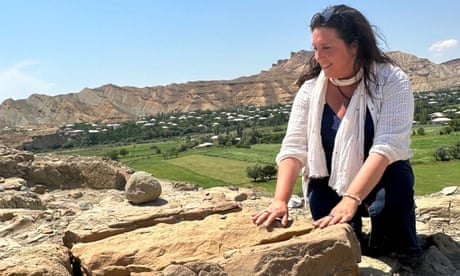
In Greek legends, the Amazons were feared and formidable women warriors who lived on the edge of the known world. Hercules had to obtain the magic girdle of the Amazonian queen Hippolyte in one of his 12 labours, and Achilles killed another queen, Penthesilea, only to fall in love with her as her beautiful face emerged from her helmet.
These horseback-riding, bow-wielding nomads, who fought and hunted just like men, have long been shrouded in myth, but archaeologists are discovering increasing evidence that they really did exist.
Excavations of graves within a bronze age necropolis in Nakhchivan in Azerbaijan revealed that women had been buried with weapons such as razor-sharp arrowheads, a bronze dagger and a mace, as well as jewellery.
Archaeologists have concluded that they could have been Amazon women who lived 4,000 years ago. These fearsome women were famed for their male-free society and their prowess on the battlefield, particularly with a bow and arrow.
Historian Bettany Hughes told the Observer: “It shows that there’s truth behind the myths and legends of ancient Greece.”
She said this evidence was all the more significant when linked to earlier finds. In 2019, the remains of four female warriors buried with arrowheads and spears were found in Russia and, in 2017, Armenian archaeologists unearthed the remains of a woman who appeared to have died from battle injuries, as an arrowhead was buried in her leg. In the early 1990s, the remains of a woman buried with a dagger were found near the Kazakhstan border.
Hughes said: “A civilisation isn’t made up of a single grave. If we’re talking about a culture that crosses the Caucasus and the Steppe, which is what all the ancients said, obviously you need other remains.”
Some of the skeletons reveal that the women had used bows and arrows extensively, Hughes observed: “Their fingers are warped because they’re using arrows so much. Changes on the finger joints wouldn’t just happen from hunting. That is some sustained, big practice. What’s very exciting is that a lot of the bone evidence is also showing clear evidence of sustained time in the saddle. Women’s pelvises are basically opened up because they’re riding horses. [Their] bones are just shaped by their lifestyle.”
She noted that the jewellery includes cornelian necklaces: “Cornelian is a semi-precious stone. You see it often when people are high priestesses or goddesses. So it’s a mark of women with status – as are mace heads.”
The finds will be revealed in a new Channel 4 series in April, Bettany Hughes’ Treasures of the World – Azerbaijan: Silk Roads and the Caucasus.
In the documentary, she says of the Amazon finds: “Slowly you’re getting these brilliant bits of evidence that are coming out of the earth. That’s often the way, with the really best stories.”
She visits the mountain village of Khinalig in the Greater Caucasus, the highest inhabited place in Europe. It is so remote that it “feels as though it’s lost in time”, she says, noting that its local language is not spoken anywhere else.
There has been a settlement there since the bronze age, and some of its 2,000 residents tell her that, in ancient times, their women disguised themselves as men with scarves – stories handed down through their generations.
She raised ancient stories of Amazons with them: “They said, ‘all of our grandmothers fought. The men were all away with the herds. The women always used to cover their faces to fight’, which is exactly what the ancient sources said, so that people didn’t know whether they were women or men.”